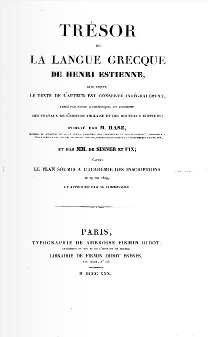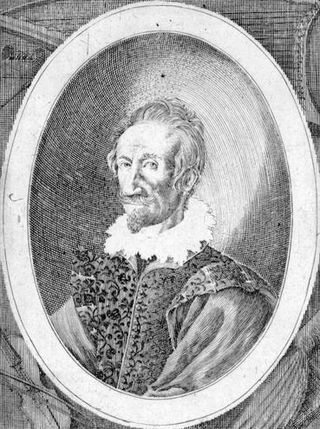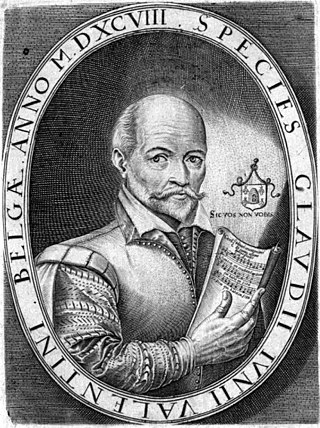Related Research Articles

Henri Estienne, also known as Henricus Stephanus, was a French printer and classical scholar. He was the eldest son of Robert Estienne. He was instructed in Latin, Greek, and Hebrew by his father and would eventually take over the Estienne printing firm which his father owned in 1559 when his father died. His most well-known work was the Thesaurus graecae linguae, which was printed in five volumes. The basis of Greek lexicology, no thesaurus would rival that of Estienne's for three hundred years.

Orlando di Lasso was a composer of the late Renaissance. The chief representative of the mature polyphonic style in the Franco-Flemish school, Lassus stands with William Byrd, Giovanni Pierluigi da Palestrina, and Tomás Luis de Victoria as one of the leading composers of the later Renaissance. Immensely prolific, his music varies considerably in style and genres, which gave him unprecedented popularity throughout Europe.
Ottaviano Petrucci was an Italian printer. His Harmonice Musices Odhecaton, a collection of chansons printed in 1501, is commonly misidentified as the first book of sheet music printed from movable type. Actually that distinction belongs to the Roman printer Ulrich Han's Missale Romanum of 1476. Nevertheless, Petrucci's later work was extraordinary for the complexity of his white mensural notation and the smallness of his font, and he did in fact print the first book of polyphony using movable type. He also published numerous works by the most highly regarded composers of the Renaissance, including Josquin des Prez and Antoine Brumel.

Johannes Ockeghem was a Franco-Flemish composer and singer of early Renaissance music. Ockeghem was a significant European composer in the period between Guillaume Du Fay and Josquin des Prez, and he was—with his colleague Antoine Busnois—a prominent European composer in the second half of the 15th century. He was an important proponent of the early Franco-Flemish School.
A chanson is generally any lyric-driven French song. The term is most commonly used in English to refer either to the secular polyphonic French songs of late medieval and Renaissance music or to a specific style of French pop music which emerged in the 1950s and 1960s. The genre had origins in the monophonic songs of troubadours and trouvères, though the only polyphonic precedents were 16 works by Adam de la Halle and one by Jehan de Lescurel. Not until the ars nova composer Guillaume de Machaut did any composer write a significant number of polyphonic chansons.
Jacques Arcadelt was a Franco-Flemish composer of the Renaissance, active in both Italy and France, and principally known as a composer of secular vocal music. Although he also wrote sacred vocal music, he was one of the most famous of the early composers of madrigals; his first book of madrigals, published within a decade of the appearance of the earliest examples of the form, was the most widely printed collection of madrigals of the entire era. In addition to his work as a madrigalist, and distinguishing him from the other prominent early composers of madrigals – Philippe Verdelot and Costanzo Festa – he was equally prolific and adept at composing chansons, particularly late in his career when he lived in Paris.

Claude Goudimel was a French composer, music editor and publisher, and music theorist of the High Renaissance.

Claude Le Jeune was a Franco-Flemish composer of the late Renaissance. He was the primary representative of the musical movement known as musique mesurée, and a significant composer of the "Parisian" chanson, the predominant secular form in France in the latter half of the 16th century. His fame was widespread in Europe, and he ranks as one of the most influential composers of the time.

Medieval French literature is, for the purpose of this article, Medieval literature written in Oïl languages during the period from the eleventh century to the end of the fifteenth century.
French Renaissance literature is, for the purpose of this article, literature written in French from the French invasion of Italy in 1494 to 1600, or roughly the period from the reign of Charles VIII of France to the ascension of Henry IV of France to the throne. The reigns of Francis I and his son Henry II are generally considered the apex of the French Renaissance. After Henry II's unfortunate death in a joust, the country was ruled by his widow Catherine de' Medici and her sons Francis II, Charles IX and Henry III, and although the Renaissance continued to flourish, the French Wars of Religion between Huguenots and Catholics ravaged the country.
France has a rich music history that was already prominent in Europe as far back as the 10th century. French music originated as a unified style in medieval times, focusing around the Notre-Dame school of composers. This group developed the motet, a specific musical composition. Notable in the high Middle Ages were the troubadours and trouvères soon began touring France, composing and performing many original songs. The styles of ars nova and ars subtilior sprung up in the 14th century, both of which focused on secular songs. As Europe moved into the Renaissance age, the music of France evolved in sophistication. The popularity of French music in the rest of Europe declined slightly, yet the popular chanson and the old motet were further developed during this time. The epicenter of French music moved from Paris to Burgundy, as it followed the Burgundian School of composers. During the Baroque period, music was simplified and restricted due to Calvinist influence. The air de cour then became the primary style of French music, as it was secular and preferred by the royal court.

Guillaume Costeley [pronounced Cotelay] was a French composer of the Renaissance. He was the court organist to Charles IX of France and famous for his numerous chansons, which were representative of the late development of the form; his work in this regard was part of the early development of the style known as musique mesurée. He was also one of very few 16th century French composers of music for keyboard. In addition, he was a founding member of the Académie de Poésie et de Musique along with poet Jean-Antoine de Baïf, and he was one of the earliest composers to experiment with microtonal composition.
Claudin de Sermisy was a French composer of the Renaissance. Along with Clément Janequin he was one of the most renowned composers of French chansons in the early 16th century; in addition he was a significant composer of sacred music. His music was both influential on, and influenced by, contemporary Italian styles.
Pierre Attaingnant or Attaignant was a French music publisher, active in Paris. He was one of the first to print music by single-impression printing, greatly reducing the labor involved, and he published music by more than 150 composers.

A branle, also bransle, brangle, brawl(e), brall(e), braul(e), brando, bran, or brantle, is a type of French dance popular from the early 16th century to the present, danced by couples in either a line or a circle. The term also refers to the music and the characteristic step of the dance.
François-Eustache du Caurroy was a French composer of the late Renaissance. He was a prominent composer of both secular and sacred music at the end of the Renaissance, including musique mesurée, and he was also influential on the foundation of the French school of organ music as exemplified in the work of Jean Titelouze.
"Baisez-moi" is a renaissance French chanson for 4 voices, anonymous in publication by Pierre Attaignant but attributed to the composer Josquin Desprez. The song was the model for masses by Petrus Roselli and the Missa Baises-moy by Mathurin Forestier.
Jehan Chardavoine was a French Renaissance composer mostly active in Paris. He was one of the first known editors of popular chansons, and the author, according to musicologist Julien Tiersot, of "the only volume of monodic songs from the 16th century that has survived to our days."

François Lesure was a French librarian and musicologist.

Trois Chansons, M 69, is a composition by Maurice Ravel for a cappella choir, set to his own texts. Ravel began the composition in December 1914 in response to the outbreak of World War I, in which he hoped to be enlisted to fight for France. While he waited for months, he wrote text and music of the three songs in the tradition of 16th-century French chansons. He completed the work in 1915, and it was published by Éditions Durand in 1916. The songs were premiered in 1917, performed by a choral ensemble conducted by Louis Aubert. They remained his only composition for a cappella choir.
References
- 1 2 Cunningham, Caroline M. (2001). "Du Tertre, Estienne". Grove Music Online. doi:10.1093/gmo/9781561592630.article.08427 . Retrieved 2024-05-28.
- ↑ Dottin, Georges (1984). La Chanson française de la Renaissance[The Renaissance French Chanson] (in French). Presses universitaires du France. pp. 45–46.